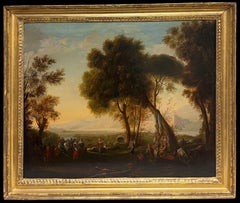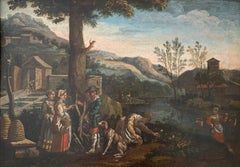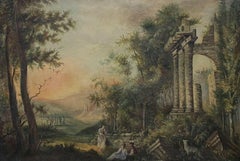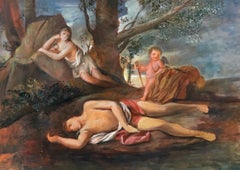Want more images or videos?
Request additional images or videos from the seller
1 of 12
Auction endedBrowse Current Auctions
G. BillonHuge French 1930's Neo-Classical Figures Gathering Signed & Dated Oil Paintingc.1935
c.1935
Price:$758.29
$3,375.42List Price
About the Item
- Creator:G. Billon
- Creation Year:c.1935
- Dimensions:Height: 29.5 in (74.93 cm)Width: 55.5 in (140.97 cm)Depth: 1 in (2.54 cm)
- Medium:
- Movement & Style:
- Period:
- Condition:
- Gallery Location:Cirencester, GB
- Reference Number:1stDibs: LU509311588842
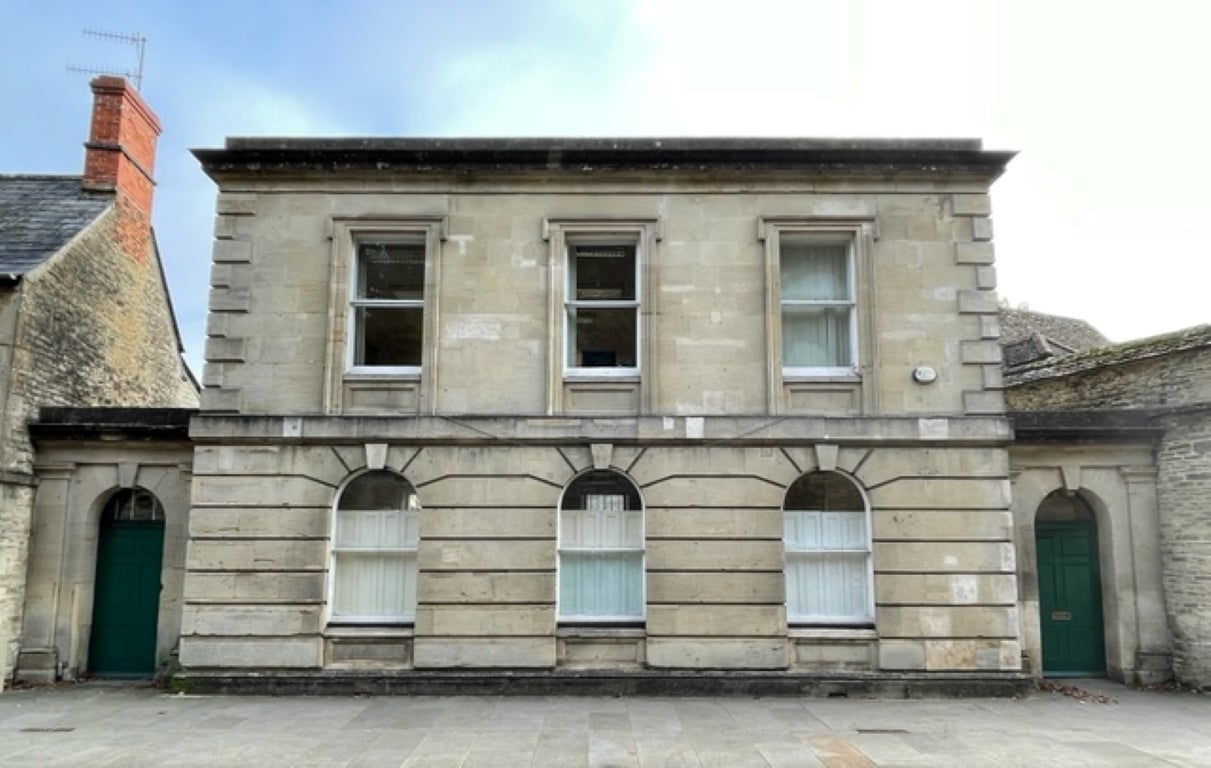
About the Seller
5.0
Platinum Seller
Premium sellers with a 4.7+ rating and 24-hour response times
Established in 1989
1stDibs seller since 2016
4,822 sales on 1stDibs
Typical response time: 1 hour
Authenticity Guarantee
In the unlikely event there’s an issue with an item’s authenticity, contact us within 1 year for a full refund. DetailsMoney-Back Guarantee
If your item is not as described, is damaged in transit, or does not arrive, contact us within 7 days for a full refund. Details24-Hour Cancellation
You have a 24-hour grace period in which to reconsider your purchase, with no questions asked.Vetted Professional Sellers
Our world-class sellers must adhere to strict standards for service and quality, maintaining the integrity of our listings.Price-Match Guarantee
If you find that a seller listed the same item for a lower price elsewhere, we’ll match it.Trusted Global Delivery
Our best-in-class carrier network provides specialized shipping options worldwide, including custom delivery.You May Also Like
Dancers in a Landscape - British 19thC art figurative landscape oil painting
Located in Hagley, England
This lovely painting is a British Old Master late 18th century or early 19th-century oil painting by Thomas Barker of Bath. It is stylistically very similar to his other works of the...
Category
Early 19th Century Old Masters Landscape Paintings
Materials
Oil
$9,926 Sale Price
20% Off
H 44 in W 56 in D 2 in
Travellers and Dogs in Landscape, Ruins on Right - Dutch Old Master oil painting
By Pieter Wouwerman
Located in Hagley, England
This lovely Dutch Old Master oil painting is attributed to artist Pieter Wouwerman. Painted circa 1660 it is figurative landscape with horseback travellers and their dogs in the foreground with ruins on their right. Beyond is a river and hilly landscape, all in the fading light of approaching dusk. There are some superb details making this an excellent Dutch Golden Age oil painting.
Provenance: Devonshire estate.
Condition. Oil on canvas, 24 inches by 20 inches and in good condition.
Frame. Housed in a complementary gilt frame, 31 inches by 27 inches and in good condition.
Pieter Wouwerman (1623-1682) was a Dutch Golden Age landscape painter. He was born in Haarlem. According to Arnold Houbraken, a biographer of artists from the Dutch Golden Age, Pieter Wouwerman was the brother of the landscape painters Jan and Philips Wouwerman, who, like his more famous brother, made a living selling Italianate landscapes in the manner of Pieter van Laer...
Category
Mid-17th Century Old Masters Landscape Paintings
Materials
Oil
$17,634 Sale Price
20% Off
H 27 in W 31 in D 2 in
Villagers in a Landscape - Flemish 17thC art figurative landscape oil painting
Located in Hagley, England
This fantastic Flemish 17th century Old Master oil painting is by Thomas Van Apshoven. It was painted circa 1650 and depicts a village with figures outside a tavern, eating, drinking and dancing. Beyond are more dwellings, villagers and animals, all under a blue summer's sky. The detail, brushwork and vibrant colouring are superb. This is an excellent example of Apshoven's work and a typical subject he loved to paint.
Provenance. Leominster estate.
Wax stamp verso.
Condition. Oil on panel, 22 inches by 17 inches and in good condition.
Frame. Housed In beautiful gilt frame, 30 inches by 25 inches and in good condition.
Thomas van Apshoven (1622– 1664) was a Flemish painter known for his landscapes with peasant scenes and genre scenes in interiors. His genre scenes depict village festivals, the interiors of taverns, village scenes or landscapes with peasants engaged in various activities, singeries, guardroom scenes and laboratories of alchemists. Some still lifes have also been attributed to him. His themes and style are close to that of David Teniers the Younger. He was born on 30 November 1622 in Antwerp as the eldest son of Ferdinand van Apshoven the Elder and Leonora Wijns. His father was a painter who had studied with Adam van Noort and had become a master of the Antwerp Guild of Saint Luke in 1596. No paintings by his father are known. His younger brother Ferdinand van Apshoven the Younger became also a successful painter. Thomas studied under his father. Some sources state that he became a pupil of the prominent genre painter David Teniers the Younger. It is more likely, however, that he was an imitator of Teniers. He was registered as a 'wijnmeester' [son of a master] in the Guild of St. Luke of Antwerp in the guild year 1645–1646. He married Barbara Janssens on 22 March 1645. The couple had four children. The godfathers of the children included the painters Victor Wolfvoet...
Category
1650s Old Masters Figurative Paintings
Materials
Oil
$7,720 Sale Price
20% Off
H 25 in W 30 in D 2 in
Wooded Figurative River Landscape - Dutch 17thC Golden Age art oil painting
Located in Hagley, England
This superb 17th century Dutch Golden Age oil painting has been more recently reattributed to Abraham Begeyn by Dr Marijke C. de Kinkelder formerly of the RKD - Netherlands Institute for Art History. Painted circa 1640 it is an Italianate wooded river landscape with drovers and their herd crossing a river with a watchtower beyond. Begeyn was one of the many 17th-century Dutch and Flemish painters to embrace the Italianate style, populating their decidedly non-Dutch, mountainous landscapes with rustic travellers and picturesque ruins bathed in warm, Mediterranean light. It has Begeyn's characteristic brightly lit cattle and grouping of figures, similar to a comparable painting in the Lichtenstein Princely Collections. The brushwork and details are superb. One can see the influence of his teacher Nicholaes Berchem (1620-1683) and the typical golden glow of the Golden Age painters. This is a stunning 17th century Golden Age oil painting and an excellent example of Begeyn's work.
Provenance: With Koetser Gallery, Zurich. Private Collection (Rhine region). Anon. sale, Dorotheum, Vienna, 22 June 2010, lot 357, as by Jacob de Heusch (€18,600).
Anon. sale, Christie's South Kensington,18 November 2015, lot 432, as 'Follower of Nicolaes Berchem'; where purchased by the present owner.
Note: Begeyn was one of the many 17th-century Dutch and Flemish painters to embrace the Italianate style, populating their decidedly non-Dutch, mountainous landscapes with rustic travellers and picturesque ruins bathed in warm, Mediterranean light.
He is thought to have studied under Nicolaes Berchem (1620-1683), a pioneer of this genre of landscape painting, and travelled extensively to Italy, London and later to Germany in 1688, where he lived out his days as court painter to Frederick III, Elector of Brandenburg (later Frederick I, King of Prussia).
The present work was previously thought to be the work of Jacob de Heusch (1656-1701), but has been more recently reattributed to Abraham Begeyn by Dr Marijke C. de Kinkelder formerly of the RKD - Netherlands Institute for Art History.
A comparable scene, which also includes Begeyn's characteristic brightly lit cattle and a similar figure group, was sold at Christie's Amsterdam, 18 November 2015, lot 110. Another can be found in the Liechtenstein Princely Collections (no.GE 290).
Condition. Oil on canvas, image size 21 inches by 18 inches and in good condition.
Frame. Housed in a beautiful gilt frame, 28 inches by 25 inches and in good condition.
Abraham Begeyn (c. 1637 Leiden - 11 June 1697 Berlin), was a Dutch Golden Age painter. Begeyn was born in Leiden. Though perhaps known mostly for his Italianate landscapes and cattle in the manner of Nicolaes Pietersz Berchem, Begyn was a highly skilled painter active in many genres, who travelled widely. According to the RKD, Begeyn's earliest known work is from 1653, though he was first accepted into the Guild of St. Luke in Leiden in 1655. He stopped paying dues in 1667, because he set off for a trip to Italy. He is registered in Rome and Naples from 1659–1660. In the rampjaar or disaster year, of 1672, he is registered in Amsterdam, and after that he lived in London, where he painted at Ham House, Surrey, together with Willem van de Velde the Younger (1633–1707) and Dirck van Bergen...
Category
1640s Old Masters Landscape Paintings
Materials
Oil
$9,368 Sale Price
20% Off
H 28 in W 25 in D 2 in
Laban Demanding the Return of the Teraphim from Rachel - Dutch Old Master art
By Willem van Nieulandt II
Located in Hagley, England
This very busy oil on panel is a Dutch Old Master painting dating to around 1620 by artist and poet Willem van Nieulandt. It is an incredibly detailed and colourful scene composed of...
Category
17th Century Old Masters Figurative Paintings
Materials
Oil
$39,678 Sale Price
20% Off
H 32 in W 26 in D 2 in
Shepherd with Animals and Riders in a Landscape - Dutch 17thC art oil painting
Located in Hagley, England
This superb Dutch Old Master oil painting is attributed to Pieter Bodding van Laer. Painted circa 1635 during the Dutch Golden Age the composition depicts a number of figures and ani...
Category
1630s Old Masters Landscape Paintings
Materials
Oil
$15,430 Sale Price
20% Off
H 35 in W 45 in D 2 in
Fete Champetre - Garden Party - French 18thC figurative landscape oil painting
Located in Hagley, England
This charming 18th century French Old Master oil painting is attributed to circle of Joseph Frans Nollekens. Painted circa 1740 it is described as a fete champetre - a form of entertainment in the 18th century, taking the form of a garden party. They were often elegant affairs and became very popular in 18th French paintings. Antoine Watteau invented the genre, from around 1710 and they were also included as a category in the French Academy. In this painting, several well dressed figures are sat in the foreground by a fountain and statue, being entertained by a musician. Beyond, a wide avenue of trees leads towards a very grand country house with countryside beyond. There is superb detail in the figures and their colourful clothing. The brushwork in the trees and sky is also superb. This is a charming example of an 18th century fete champetre and of a French Old Master oil painting.
Provenance. Gloucester estate.
Condition. Oil on canvas. Image size 49 inches by 30 inches and in good condition.
Frame. Housed in a fine gilt frame, 56 inches by 37 inches and in good condition.
Josef Frans Nollekens or Joseph Frans Nollekens (1702–1748)[2] was a Flemish painter who was principally active in England where he is often referred to as "Old Nollekens" to distinguish him from his famous son, the sculptor Joseph Nollekens. He painted conversation pieces, galant companies and fêtes champêtres in the style of Watteau, genre scenes as well as portraits. He was also active as a picture restorer.
A fête champêtre was a form of entertainment in the 18th century, taking the form of a garden party. This form of entertainment was particularly practised by the French court, where in the Gardens of Versailles and elsewhere areas of the park were landscaped with follies, pavilions, and temples to accommodate such festivities. The term is a French expression, very literally translating as "party in the fields", meaning a "pastoral festival" or "country feast" and in theory was a simple form of entertainment, perhaps little more than a picnic or informal open air dancing. In practice, especially in the 18th century, the simplicity of the event was often contrived. A fête champêtre was often a very elegant form of entertainment involving on occasions whole orchestras hidden in trees, with guests sometimes in fancy dress. Such events became a popular subject in French 18th-century painting, representing a glamourized aristocratic form of pastoral, with "scenes of well dressed dalliance in a park setting". Antoine Watteau invented the genre, from around 1710, and is its best exponent, imitated by others such as Nicolas Lancret and Jean-Baptiste Pater...
Category
1740s Old Masters Landscape Paintings
Materials
Oil
$17,634 Sale Price
20% Off
H 37 in W 56 in D 2 in
19th Century Roman Landscape oil on canvas with Giltwood Frame
Located in Rome, IT
Amaizing 19' century Roman landscape depicting a part of Villa Borghese with Trinità dei Monti.
With a finely carved gilt wood coeval frame.
Measurements with frame cm 65 x78 wit...
Category
19th Century Old Masters Landscape Paintings
Materials
Oil
$5,418
H 25.6 in W 30.71 in D 1.97 in
19th Century Roman Landscape oil on canvas with Giltwood Frame
Located in Rome, IT
Amaizing 19' century Roman landscape depicting a part of Villa Borghese with Trinità dei Monti.
With a finely carved gilt wood coeval frame.
Measurements with frame cm 65 x78 wit...
Category
19th Century Old Masters Landscape Paintings
Materials
Oil
$5,415
H 25.6 in W 30.71 in D 1.97 in
Outstanding 18' century Paintings The Wedding Feast of Bacchus and Ariadne
Located in Rome, IT
Pair of large painting oil on canvas with the Wedding Feast of Bacchus and Ariadne scene .
Italy 18' century .
Amazing landscape background and roman Temple with classical archite...
Category
Early 18th Century Old Masters Figurative Paintings
Materials
Oil
$216,753
H 61.03 in W 88.59 in D 1.58 in
More From This Seller
View AllFine 17th Century Dutch Golden Age Old Master Oil Figures in Classical Landscape
Located in Cirencester, Gloucestershire
Figures in Classical Landscape
Dutch School, 17th century
oil on canvas, framed
inscribed verso to label
framed: 23 x 27 inches
canvas : 20 x 24 inches
Provenance: private collection...
Category
17th Century Old Masters Landscape Paintings
Materials
Oil
FINE 17th CENTURY ITALIAN OLD MASTER OIL PAINTING - FIGURES GARDENING LANDSCAPE
Located in Cirencester, Gloucestershire
"The Working Landscape"
Italian School, 17th century
oil painting on canvas, framed
canvas: 42.5cm x 60cm
framed: 50.5cm x 68cm
Fine quality Italian Old Master oil painting on can...
Category
Mid-17th Century Old Masters Landscape Paintings
Materials
Canvas, Oil
$8,161 Sale Price
20% Off
Very Large Antique French Classical Romantic Oil Painting Ancient Ruin Landscape
Located in Cirencester, Gloucestershire
Artist/ School: French School, 19th century
Title: Classical Landscape with figures amongst ancient ruins.
Medium: oil painting on canvas, unframed.
canvas: 24.5 x 36 inches
P...
Category
19th Century Old Masters Landscape Paintings
Materials
Oil
$2,426 Sale Price
20% Off
Mythological Scene Various Classical Figures in Landscape
Located in Cirencester, Gloucestershire
Artist/ School: French School, 20th century
Title: Mythological Scene with Figures in Classical Landscape
Medium: oil painting on board, unframed
Size:
board: 19.75 x 27 inches
...
Category
20th Century Old Masters Figurative Paintings
Materials
Oil
$1,372 Sale Price
86% Off
HUGE 17thC ITALIAN OLD MASTER OIL PAINTING - KING & COURT FIGURES ROMAN BUILDING
Located in Cirencester, Gloucestershire
Artist/ School: Italian School, 17th century.
Title: A King and Queen before court figures, amidst a classical landscape with Roman columns.
Medium: oil painting on canvas, framed
...
Category
17th Century Old Masters Figurative Paintings
Materials
Canvas, Oil
19th Century Continental Oil Painting City River Busy Shipping Scene framed
Located in Cirencester, Gloucestershire
European School, 19th century
View of boats on water and buildings
oil on board, framed
framed: 16 x 22 inches
board: 11.5 x 17.5 inches
private collecti...
Category
Mid-19th Century Old Masters Landscape Paintings
Materials
Oil
$1,983 Sale Price
20% Off
